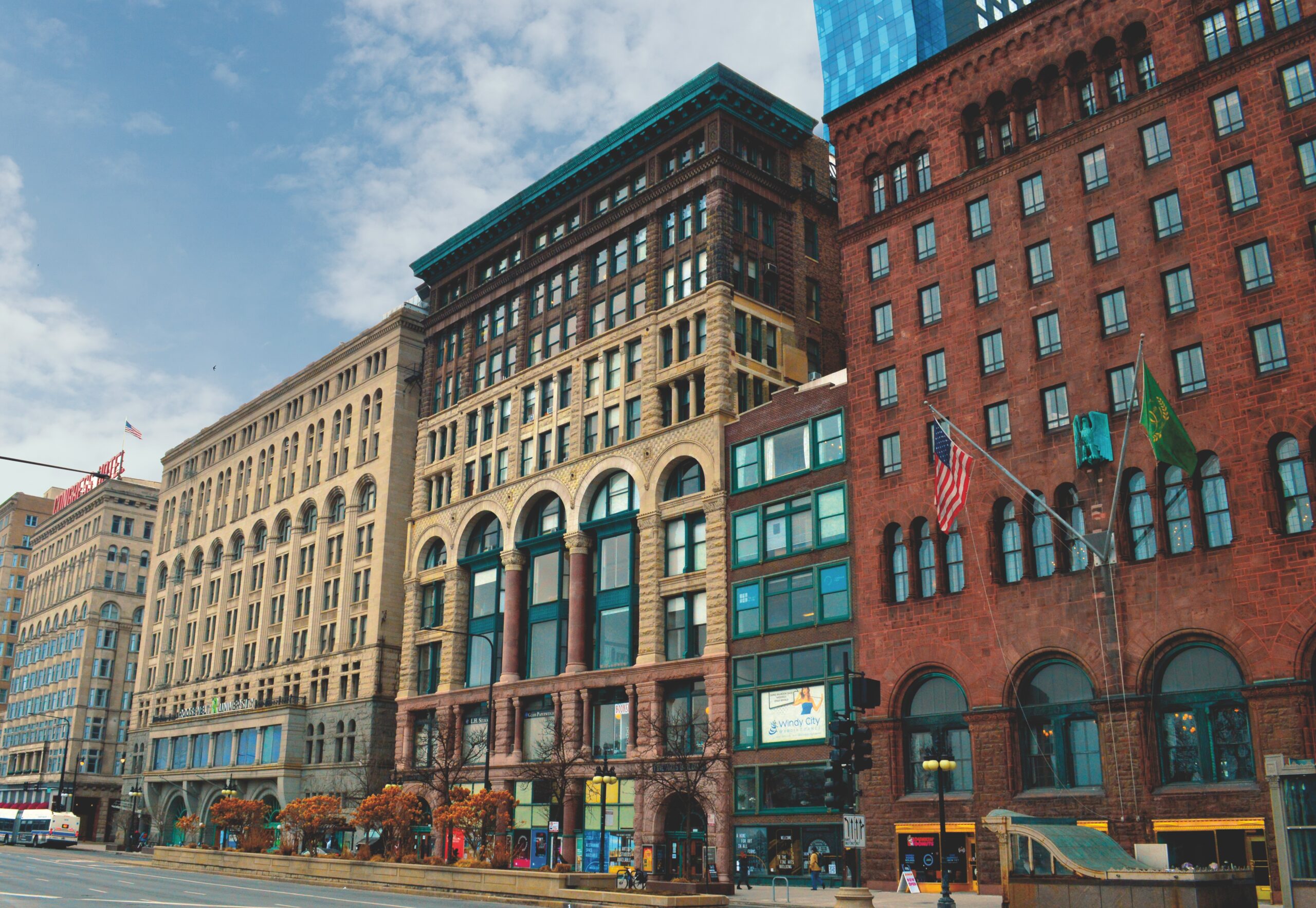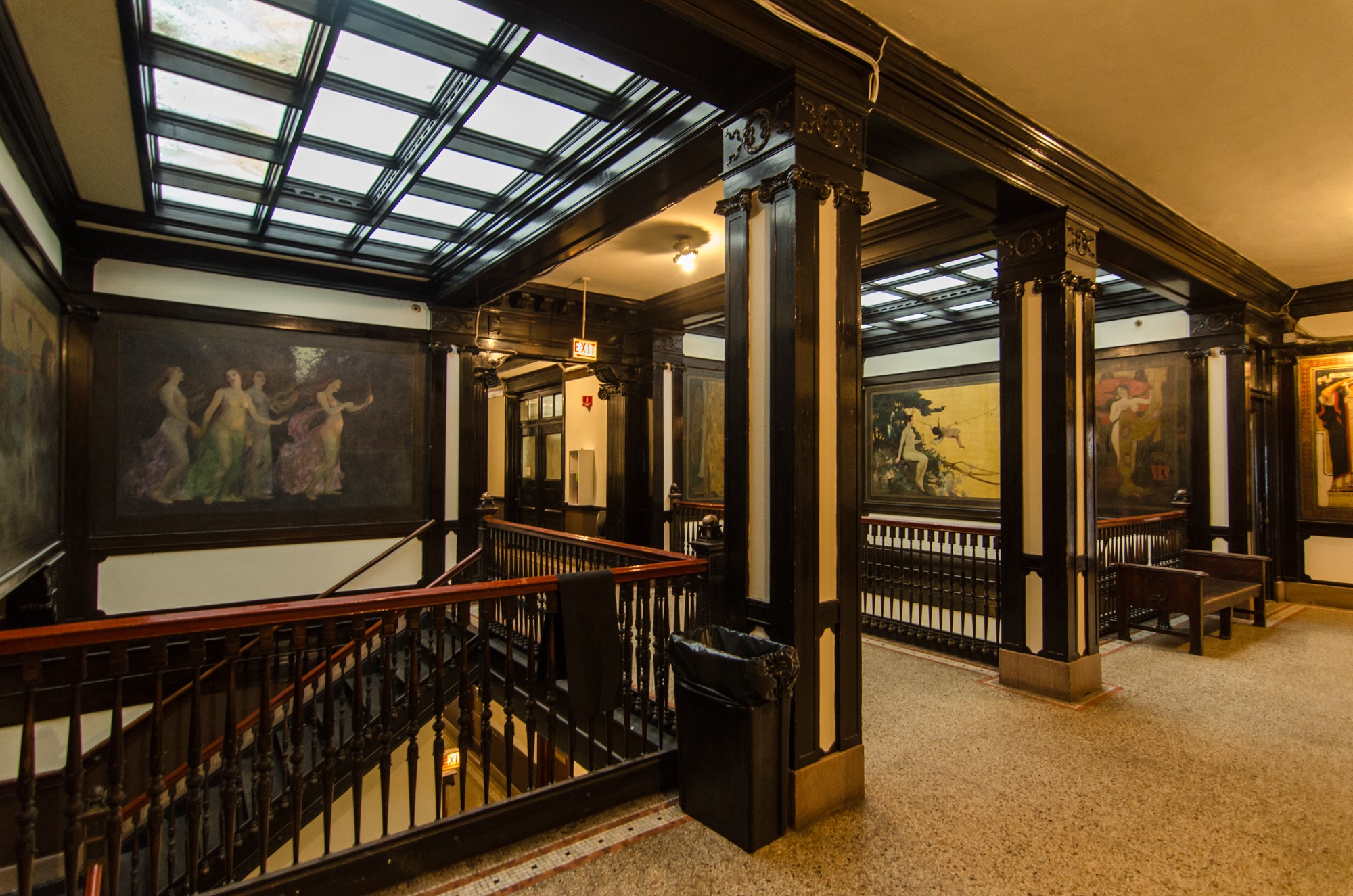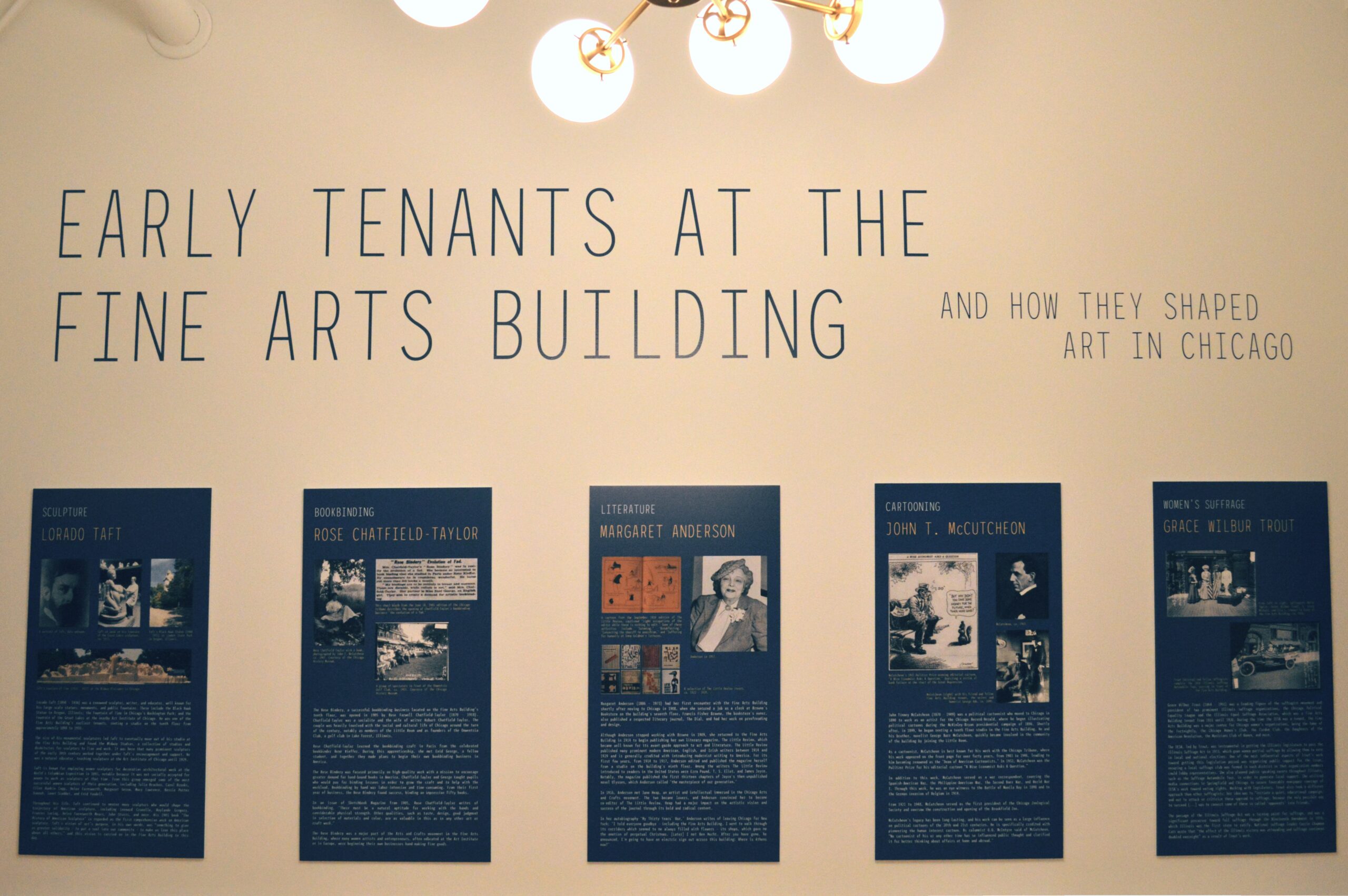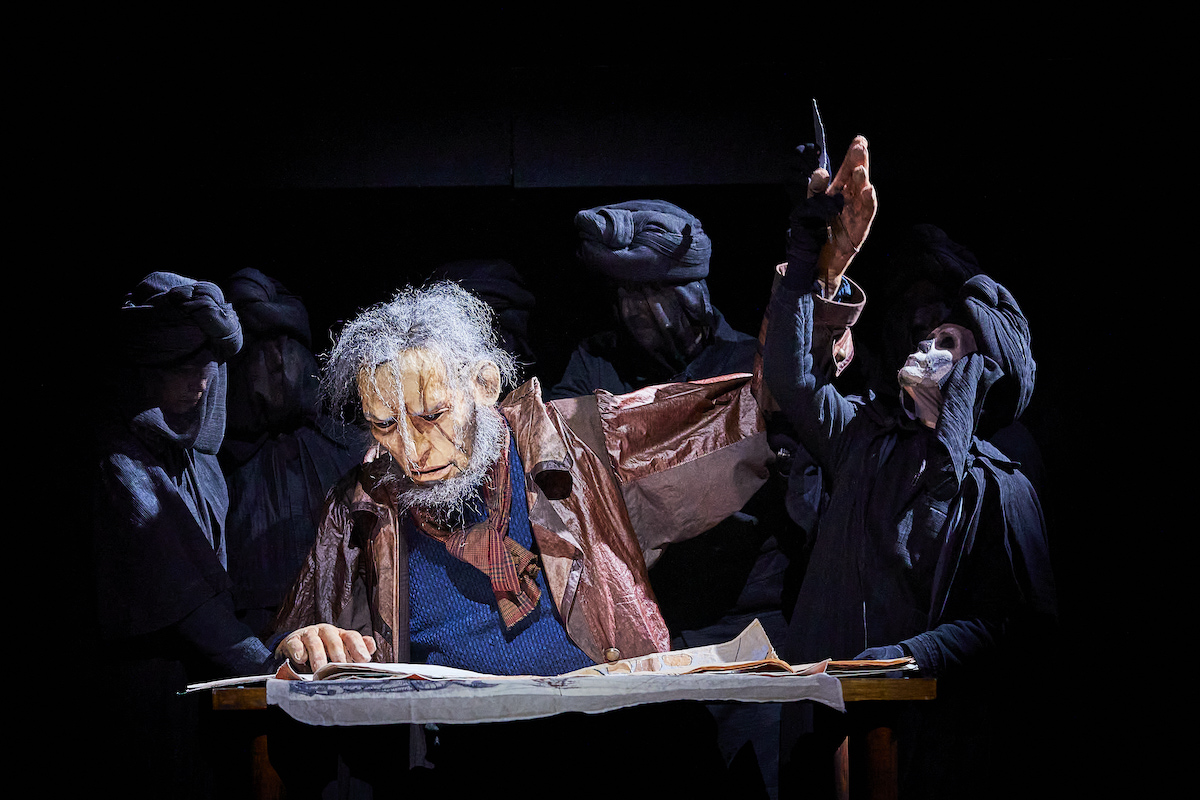The first things you notice when you get off the elevator or walk up the stairs are the sounds: the tinkle of a piano perhaps or the voice of a soprano reaching for the highest of notes. Students patiently wait for their music lessons, sitting on wooden benches. The place looks old and feels old in a timeless way. The long hallways, dimly lit, echo an earlier era, offering a glimpse into another century.
The Fine Arts Building looks as if it has been at 410 S. Michigan Ave. forever even though tenants have come and gone, of course. Consider a few: the mid-century Piccadilly, an elegant restaurant on the fourth floor, catered to tenants and non-tenants alike (“all sandwiches served on your choice of bread”); the (still) much-missed Fine Arts Theatre had a good run, from 1982 to 2000 (fun fact: the last movie I saw there was Joe Gould’s Secret); the popular Artist’s Café closed in 2019, after nearly 60 years.
But the building itself remains a constant presence, seemingly living up to the inscription etched in the entranceway: ALL PASSES—ART ALONE ENDURES. Tenant Blair Thomas acknowledges the significance of the building by asserting that it is “more powerful” than any one person; that it is “greater than the individual artist.” He pauses for a moment to offer his own take on the motto. “I don’t think all art endures,” he says, “but artistic impulses endure. Creativity endures.” He pauses again. “We’re all temporal.”
In October, the building, which was declared a Chicago landmark in 1978, will celebrate its 125th anniversary with public events that will include a free concert in the Studebaker Theater as well as additional performances and demonstrations throughout the building. Mayor Brandon Johnson even proclaimed October 13, 2023, to be Fine Arts Building Day in the city. For those who want to learn more about the building's past, a permanent exhibit on the fifth floor chronicles the history of the building while historic plaques are mounted outside many of the studios.

An Arts Colony Like No Other
The Fine Arts Building was one of two arts colonies in Chicago when it opened in 1898. The other was the Tree Studios in a neighborhood once called Towertown because of its proximity to the historic Water Tower. (Today we know it as the more prosaic River North.) The Tree Studios lost its art colony status years ago while Fine Arts retains its landmark status and its link to arts-related businesses.
The building owes its existence to the Studebaker Brothers, wagon and carriage makers based in South Bend, Indiana––the same family that manufactured the famous Studebaker cars. The Studebakers acquired the land that the building stands on in 1885. The following year the family hired renowned architect S. S. Beman—who designed the Pullman community on the far South Side as well as the still-standing Kimball Mansion in the Prairie Avenue Historic District—to build them a showcase building that would attract attention. And a showcase it was: an eight-story architectural wonder consisting of four stories for their showroom and four stories where the brothers could assemble their carriages. An annex was built next door but even so the success of their carriage business outgrew the space, which led to a larger building on South Wabash Avenue to store and display their carriages, leaving Beman’s masterwork essentially empty. Enter Charles C. Curtiss.
Curtiss was the son of James Curtiss, a former Chicago mayor. The younger Curtiss worked as a salesman for Field, Palmer & Leiter, the precursor to Marshall Field’s, and then as a bookkeeper for Lyon & Healy, the harp makers. Later Curtiss became manager and treasurer of George F. Root & Sons Music Company before becoming the first manager of the Fine Arts Building. Unlike his father, Charles Curtiss much preferred the arts to politics. In particular, he watched, with interest, the success that Judge Lambert Tree and his wife Anna Tree were having north of the river.
Inspired by Tree Studios, Curtiss persuaded the Studebakers to convert the building into a 10-story complex of artists and artist-related studios, essentially creating a high-rise arts colony in the heart of Michigan Avenue. Given its location––its neighbor was the Auditorium Theatre––it seemed like a reasonable idea. Two floors were added and a six-story open space called Venetian Court created in the center of the building. Upper floors were dedicated to artist studios and galleries as well as various clubs and organizations. To cap it off, the building was given a new name that reflected Curtiss’ vision: the Fine Arts Building. Curtiss Hall on the tenth floor is named after him.
From Theater to Literary Magazines to Books
During its early years, the building was the home to architects, artists, writers, publishers, illustrators, booksellers, musicians, art galleries, bookbinders, sheet music publishers, and more—many of them household names to this day. L. Frank Baum and William W. Denslow collaborated on The Wonderful World of Oz in Denslow's tenth floor studios. For a few short years Room 1020 was the studio of an obscure architect by the name of Frank Lloyd Wright. Sculptor Lorado Taft, best known today as the designer of Fountain of Time at the west end of the Midway Plaisance in Hyde Park, also had a studio on the same floor and there were plenty of others to keep him and the others company: portrait painter Ralph Clarkson, Chicago Tribune cartoonist John McCutcheon, and the illustrators and siblings Frank X. and Joseph C. Leyendecker. Columnist George Ade had a studio on the eighth floor. It was the Leyendecker brothers who convinced their fellow artists to paint the tenth floor murals. Residents and visitors alike can still see those murals today, including works by Charles Francis Browne, Frederic Clay Bartlett, Oliver Dennett Grover, and Frank X. Leyendecker himself.

The lower floors also had their share of prominent tenants. In Room 825 Anna Morgan taught speech and movement training for actors and singers and staged recitals and performances that were open to the public. Morgan was an influential figure in the creation of the Little Room, a small group of artists who met each Friday afternoon in Clarkson’s tenth floor studio to discuss art and literature. Artists being artists, the gatherings soon evolved into theatrical productions, albeit on a modest scale. In 1904, for example, Morgan and other Little Roomers presented a dramatization of McCutcheon’s cartoons called The Bird Center. Performers included some of the most notable movers and shakers in Chicago’s artistic community at the time, including architect Howard Van Doren Shaw; Melville E. Stone Jr., founder of the Chicago Daily News; authors Elia W. Peattie and Edith Wyatt; editor and writer Clara Laughlin; and Harriet Monroe, founder of Poetry magazine, as well as Clarkson, Browne, Morgan, and McCutcheon.
Another important cultural tenant was the Chicago Little Theatre. The Little Theatre created the template for what would later become the off-Loop theater movement and Chicago’s do-it-yourself alternative theater ethos. The husband and wife team of Maurice Browne and Ellen Van Volkenburg established the Little Theatre in 1912 on the fourth floor where they created a small proscenium theater that seated around 90 people. It also featured a tearoom that was open at intermission and after the show.
The Little Theatre had a short life but they were productive years, typically staging five productions per season. Over a five-year span, they produced nearly 50 plays, including Greek tragedies and modern fare such as Ibsen’s Hedda Gabler, Shaw’s Mrs. Warren’s Profession, Synge’s Deirdre of the Sorrows, and Yeats’ On Baile’s Strand.
The building has also been home to a fair number of prominent literary magazines. Francis Fisher Browne started the Dial here while the Saturday Evening Post also had an office in the building. But no magazine was as important and influential as Margaret Anderson’s Little Review, which she ran out of her office in Room 917.
Founded in 1914, the Little Review took its name as homage to the Little Theatre. Anderson published the best of the 20th century modernists and radicals, including T.S. Eliot, Ford Madox Ford, William Carlos Williams, Amy Lowell, e.e. cummings, and Gertrude Stein. Most notoriously she serialized James Joyce’s literary classic Ulysses, which led to the famous obscenity trial in 1921 (but that’s another story). Everybody came to see Anderson in her studio: journalist Ben Hecht, poet Carl Sandburg, and author Edgar Lee Masters, to name a few. Later, she would rent a cheaper studio in the building, in Room 834 on the Venetian Court “where the fountain and the pianos tinkled all day.”
Anderson left Chicago in 1917 to move to Greenwich Village. On her last day in the building she bid a sad farewell by walking through its corridors one last time. She talked to the “elevator boys,” as she called them, who assured her that the building wouldn’t be the same without her. She went around the corner to buy a rose from a flower woman. She went to a symphony concert and then returned to the Fine Arts one last time where she bumped into Hecht. After you have gone, he reportedly told her, he was going to put up an electric sign across the building that would read, “Where is Athens now?”
With or without Anderson, the building endured. Indeed, countless cultural highlights have taken place in the building over the years: in 1910, Sarah Bernhardt performed there; the Yiddish Art Theatre offered Yiddish-language plays in the late 1930s; in 1941 Orson Welles and John Houseman presented Native Son, a play adapted from Richard Wright's novel; from 1950 to 1955, the Studebaker Theater was used as studios for NBC; the following year Bernie Sahlins, of Second City fame, launched the Studebaker Theater Company. And much more.

The Fine Arts Building has been home to several bookstores since it opened. Frank Lloyd Wright designed Browne’s Bookstore in Room 733 (Browne was also the founder and editor of the Dial). With its fireplace, long reading room, and armchairs, Margaret Anderson called it “the most beautiful bookshop in the world.” And it was at Browne’s, she noted, where tea was served “and everyone was smart. All Chicago society came to Browne’s Bookstore.”
Booksellers Row, on the street level, lasted for about a dozen years, before closing in 2000. And there was the short-lived Rain Dog, which also included, a coffee shop. There were others. Both Jane Addams Bookstore and Selected Works were located on the second floor. In April 2021, during the height of the pandemic, Javier Ramirez and Kristin Gilbert opened the building’s newest bookstore, Exile in Bookville, in the same second floor space. Its name is a nod to Liz Phair’s iconic Chicago album Exile in Guyville. “To pay homage to Chicago,” says Gilbert. “It’s a fantastic album.”
Exile took over from the former Dial bookstore, named in honor of the magazine that used to be in the building. Exile specializes in small presses, translations, and, of course, music titles. The selections reflect the tastes and values of the owners. Approximately, 60 to 70 percent of Exile’s customers are tourists while the rest are regulars and students. On average they hold two to three events per week. In 2022, they presented an impressive 165 events.
Eagled-eyed customers are sure to see the distinctive charcoal drawings of local authors and editors by the Russian-born artist, painter, and writer Dimitry Samarov above the shop’s front desk. Samarov is also a former cab driver and perhaps best known for his Hack: Stories from a Chicago Cab. The literary figures include Alex Kotlowitz, Sandra Cisneros, Stuart Dybek, Lorraine Hansberry, Harriet Monroe, Leon Forrest, jane heap and Margaret Anderson, Willard Motley, Gwendolyn Brooks, and Sara Paretsky (no, not David Bowie, notes Ramirez with a chuckle, as some customers think).
In the tradition of the Little Room, Ramirez and Gilbert host an informal cocktail hour every day around 4pm for customers who happen to be there as well as for fellow tenants.
Tough Times
The building has gone through some tough times over the decades, years of fortune followed by years of decline. Between World War I and the Great Depression, many, if not most, of the tenants fled. During this period there was also a succession of owners. The building fell into disrepair and went in and out of bankruptcy. At one point it was sold at a foreclosure auction. At its nadir, it even had mob connections. According to the Chicago Tribune, Abraham Teitelbaum, Al Capone’s former lawyer, owned it in the 1950s.
Eventually, though, things began looking up. In May 1979, Tom Graham purchased the building for “slightly more than $1 million,” according to media reports. At that point more than 60 percent of the building was empty. Fortunately, for the Fine Arts Building, Graham was a visionary much like his predecessor Charles Curtiss. And like Curtiss, he too saw the building as an alternative in a sea of commercial glut. Architect David Swan, author of a book about the building, even called Graham “our Charles Curtiss. It would long ago have been sold to a condo developer if not for Tom.” Slowly the building came back to life, buoyed by the same type of people it had attracted over the decades: artists, dancers, musicians, and teachers. While most everything around it changed, the Fine Arts remained its own soulful self. “I discourage people who are looking for modern office space,” Graham told the Tribune in 1986.

In 2005, Bob Berger purchased the building for more than $10 million. More than a dozen years later, in 2021, the Berger Realty Group embarked on a $3 million renovation. Also in the same year, Jacob Harvey, formerly the artistic director of the Greenhouse Theater Center, was hired as the “first-ever” managing artistic director of theaters in the building. Prior to that the Studebaker Theater reopened in 2016 for live performances; since then it has presented work by Chicago Opera Theater, the Chicago International Puppet Theater Festival, Chicago Jazz Orchestra, and the Lloyd Price musical, Personality. In 2022, the NPR quiz show, “Wait, Wait…Don’t Tell Me,” hosted by Peter Sagal, took up residence with live tapings.
Today the Fine Arts Building is 98 percent leased, according to Harvey, with 110 tenants. They include architects, dancers, photographers, literary agents, piano teachers, voice instructors, and individual authors as well as such prominent companies as the Chicago Youth Symphony Orchestras, the Jazz Institute of Chicago, Performers Music, William Harris Lee, maker of fine stringed instruments, and Bein & Fushi, dealer and appraiser of rare violins.
And yet even the Fine Arts Building has had to change with the times.
The Elevator Boys
One of the latter day “elevator boys” was an Irish immigrant from County Mayo by the name of Tommy Durkin. He emigrated to Chicago at age 16 and found work at the Drake Hotel before leaving in 1950 to come to the Fine Arts. Once there, he never left. Durkin was famous for hosting annual Christmas parties in his basement room for staff and select tenants (and their guests) that he paid for out of his own pocket. But, as he made clear, it was never meant to be a Christmas Party. “It’s a Notre Dame party,” Durkin said. “We wouldn’t do all this just for Christmas.” He also hosted a corned beef and cabbage luncheon each year to celebrate St. Patrick’s Day.
Why was the gregarious Durkin such a big deal?
Durkin staffed the controls of elevator car No. 1 for decades. In 2000, a bronze plaque was installed outside the elevator in honor of his 50th anniversary—it’s still there. Durkin retired from his post in 2010 (it was his second retirement—he originally retired in 2000 until the tenants and management convinced him to return on a part-time basis) and died three years later at age 81.
And now, alas, the era of the “elevator boys” is about to end. In late August, management announced that due to “cost prohibitive and challenging” issues the quaintly old-fashioned and much beloved elevators would be modernized and converted into mechanical elevators over a two-year period. Even so, management promised to make every effort to allow the elevator operators to “remain part of our community.”
Either way, it will truly mark the end of an era in the building's history.
Murder in the Building
Although the Fine Arts Building generally is a quiet and peaceful place, it has had its share of high drama. In an incident worthy of a certain popular Hulu show, consider the unfortunate case of Everett Clark, a former radio actor and drama coach.
As announcer and narrator for the nationally broadcast Theater of the Air and a cast member of the radio series “The Shadow,” Clark was a minor celebrity in his own right. He had taught drama classes since the 1950s. But one fateful day in September 1980, Clark met an untimely demise in his own studio.
Clark’s fellow tenants had heard screams but, given the nature of his profession, his neighbors shrugged it off as just a typical day at work for the 68-year old coach. “No, Paul, God, no, Paul,” Clark reportedly bellowed at the top of his lungs. But Clark was not acting out a scene. This was all too real. As everyone would soon discover, Clark (also spelled Clarke in some reports) had been stabbed to death in the chest and neck, his body found on a small stage in his tenth floor studio, a pair of bloody scissors lying nearby.
Clark’s killer turned out to be one of his students, Paul DeWit, an unemployed 22-year old troubled soul: DeWit was a paranoid schizophrenic who suffered delusions that everyone—his coach, his mother, even, strangely enough, the mafia—wanted him dead. In 1981, he was found guilty but determined “mentally ill” at the time of the slaying and sentenced to 22 years in prison.
“A Comradeship That Is Sweet to Remember”
In the early days of the building, tenants took a strong interest in each other’s work, as they still do. Visitors came too, enticed by the idea of a building dedicated to the arts. “It was a show place,” wrote Anna Morgan in her 1918 memoir, My Chicago, “a rendezvous where you were sure to see interesting people.” Indeed, for a few glorious years, “it was almost a continuous party,” she said. Weekly occurrences featured afternoon teas hosted in Anna Morgan's studio and Ralph Clarkson's Little Room and “night spreads” usually taking place in Charles Francis Browne’s studio. “There was an informality, a comradeship that is sweet to remember,” noted Morgan.
Morgan recalled one party in particular that began with a buffet supper that started in her studio at 7pm and ended with a dance in her gymnasium at 3 in the morning with ragtime music. She also presented several burlesque performances on her small stage. A note on the program encouraged participants to “Eat and drink, for tomorrow we may not feel like it.”
That sense of camaraderie continues to this day.
“Everyone looks out for each other. Everyone does what they can for each other,” Gilbert of Exile in Bookville told me.
Others echo that sentiment.
“When I’m here I know I’m around my people,” says writer Barbara Burgess. “This is a haven.”
And many, if not most, of the current tenants appreciate the building’s vaunted past. People know they work in a special place. They can feel it. “I’m surprised the whole place isn’t haunted, the wood, the floors, the elevators, the smell,” says piano teacher Lisa Browne.
Puppeteer Blair Thomas, the co-founder of the now-defunct Redmoon Theater and the mastermind behind the Chicago International Puppet Theater Festival, moved into his current space during the pandemic summer of 2021. Prior to that he was on the fifth floor in Room 501. When he moved into his new fourth floor space he didn’t know it was the original home of the Little Theatre but he “was delighted to find out.” The Little Theatre’s tearoom was in the studio where Thomas is now. “It’s always an inspiration to go to work,” he said, and an honor to walk down the halls and think of those who preceded him. “I do think of a young Maurice Brown.” He acknowledges his fellow tenants—past and present––in a way that Charles Curtiss surely would have appreciated.
“It’s a building full of dreamers,” he concludes, “not of practical people.”
The Fine Arts Building at 410 S. Michigan Ave. will celebrate its 125th anniversary with a public event, on Friday, October 13, from 5 to9pm, which will open all ten floors of the artists’ studios. For more information, see www.fineartsbuilding.com.
Did you enjoy this post and our coverage of Chicago’s arts scene and sometimes beyond? Please consider supporting Third Coast Review’s arts and culture coverage by making a donation by PayPal. Choose the amount that works best for you, and know how much we appreciate your support!
